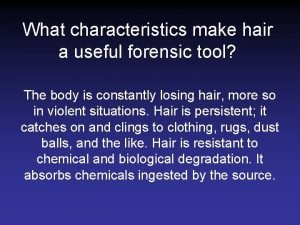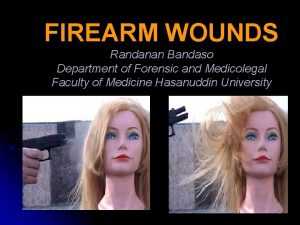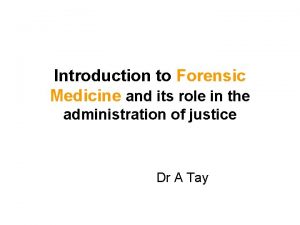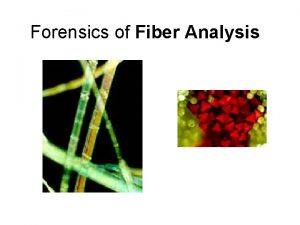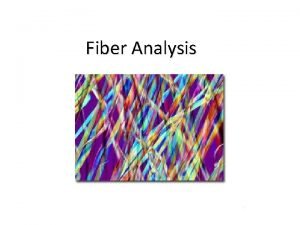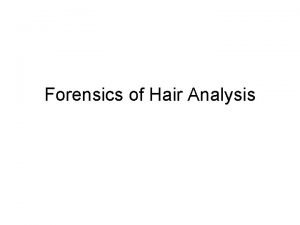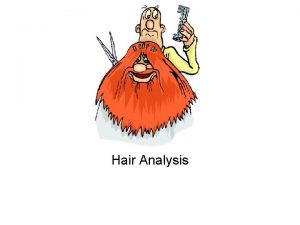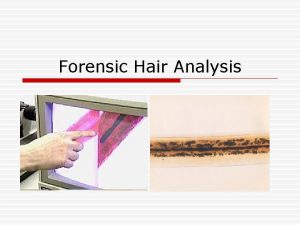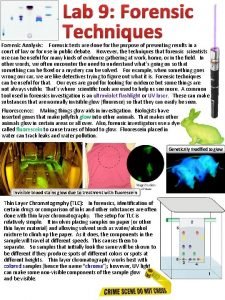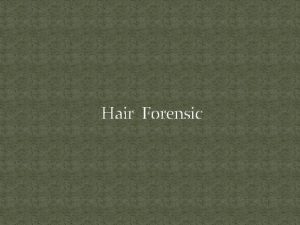FORENSIC HAIR ANALYSIS 1 INTRODUCTION A hair without






















- Slides: 22

FORENSIC HAIR ANALYSIS 1

INTRODUCTION • A hair without the follicle and its nuclear DNA cannot provide individual evidence. • Hair can yield class evidence. • Chemical tests performed on hair can reveal drugs, toxins, heavy metals and nutritional deficiencies. • mt. DNA from hair can reveal some of a suspect’s or victim’s family relationships. • Secondary Transfer is very common in animal hairs • Hair has a tough outer covering that means it doesn’t easily decompose Forensic Science: Fundamentals & Investigations, 2 e Chapter 3 All rights Reserved Cengage/NGL/South-Western © 2016

Chemical tests can provide a history of drugs and toxins Forensic Science: Fundamentals & Investigations, 2 e Chapter 3 3

HISTORY OF HAIR ANALYSIS 1883: Alfred Swaine Taylor and Thomas Stevenson covered hair in a forensic science text. It included drawings of human hair under the microscope. 4

HISTORY OF HAIR ANALYSIS o 1910: Victor Balthazard and Marcelle Lambert published a comprehensive study of hair called “The Hair of Men and Animals. ” It included microscopic studies of hairs from many different animals. Forensic Science: Fundamentals & Investigations, 2 e Chapter 3 5

HISTORY OF HAIR ANALYSIS 1934: Dr. Sydney Smith, analyzed hairs side by side using a comparison microscope. Helped solve the case of a murder of an eight year old girl. Forensic Science: Fundamentals & Investigations, 2 e Chapter 3 All rights Reserved Cengage/NGL/South-Western 6 © 2016

HISTORY OF HAIR ANALYSIS Today: Standard procedures of hair analysis include microscopic examination and DNA analysis. Forensic Science: Fundamentals & Investigations, 2 e Chapter 3 7

THE FUNCTIONS OF HAIR • Regulates body temperature • Decreases friction • Protects against sunlight • Acts as a sense organ • Humans are born with about 5 million hair follicles. (2% on on the head and they decrease with age!) Forensic Science: Fundamentals & Investigations, 2 e Chapter 3 All rights Reserved Cengage/NGL/South-Western 8 © 2016

THE STRUCTURE OF HUMAN HAIR • Human hair consists of a follicle and a shaft. • Follicle – club shaped structure in the skin • Papilla – network of blood vessels that supply nutrients to grow the hair • Sebaceous gland – secretes oil that conditions hair • Erector muscle – causes the hair to stand upright • Nerve cells – wind around the follicle and stimulate the muscle in response to environment stimuli Forensic Science: Fundamentals & Investigations, 2 e Chapter 3 All rights Reserved Cengage/NGL/South-Western 9 © 2016

THE STRUCTURE OF HUMAN HAIR (CONTINUED) • The hair shaft is composed of a strong and flexible protein called keratin. It is made up of three layers: – An inner medulla – A cortex – An outer cuticle Forensic Science: Fundamentals & Investigations, 2 e Chapter 3 All rights Reserved 10 © 2016 Cengage/NGL/South-Western

STRUCTURE - CUTICLE • The cuticle is a transparent outer layer of the hair shaft. • Made of overlapping scales that all point outward from the scalp (proximal end) to the edge (distal end) • Knowing the “younger” side of the hair makes the timeline of drugs and toxins detected by analysis more valid. Forensic Science: Fundamentals & Investigations, 2 e Chapter 3 All rights Reserved 11 © 2016 Cengage/NGL/South-Western

STRUCTURE - CORTEX • Contains the melanin (pigment) • The granule distribution can vary from person to person Forensic Science: Fundamentals & Investigations, 2 e Chapter 3 All rights Reserved 12 © 2016 Cengage/NGL/South-Western

STRUCTURE - MEDULLA • Center of the hair • Can be a hollow tube • Patterns of pigmentation are classified into 5 groups Forensic Science: Fundamentals & Investigations, 2 e Chapter 3 All rights Reserved 13 © 2016 Cengage/NGL/South-Western

TYPES OF HAIR • In humans, hair varies from person to person, and even varies depending on its location on a particular person. • For an individual person, hair can vary based on its location on the body. • To compensate for inconsistencies that occur, 50 hairs are usually collected from a suspect’s or victim’s head. Forensic Science: Fundamentals & Investigations, 2 e Chapter 3 All rights Reserved Cengage/NGL/South-Western © 2016 14

HAIR FROM DIFFERENT PARTS OF THE BODY 1. Head hair – Generally circular or elliptical in the cross section 2. Eyebrows and eyelashes – Also circular but often have tapering ends 3. Beard and mustache hair – Tend to be thick and triangular in cross section, usually coarse and may have double medulla 4. Underarm hair 5. Auxiliary or body hair – Tends to be oval or triangular, have blunt tips and generally are frayed at the ends 6. Pubic hair – Tends to be oval or triangular, has irregular buckling along the shaft Forensic Science: Fundamentals & Investigations, 2 e Chapter 3 All rights Reserved 15 © 2016 Cengage/NGL/South-Western

THE LIFE CYCLE OF HAIR Hair proceeds through three stages as it develops. • Anagen stage – Lasts approximately 1000 days – 80 -90% of human hair is in this stage – Active growth with cells around the follicle rapidly dividing • Catagen stage – The hair stops growing and the follicle recedes. – 2% of human hair is in this stage – Sometimes turns gray at this stage • Telogen stage – The hair follicle is dormant and hair is easily lost. – 10 -18% of human hair is in this stage • There is no pattern as to which hairs on the head are in a particular stage at any time. Forensic Science: Fundamentals & Investigations, 2 e Chapter 3 All rights Reserved Cengage/NGL/South-Western © 2016 16

THE LIFE CYCLE OF HAIR Forensic Science: Fundamentals & Investigations, 2 e Chapter 3 All rights Reserved 17 © 2016 Cengage/NGL/South-Western

TREATED HAIR • Hair can be treated in many different ways. • Bleached – removes pigment granules and gives hair a yellowish color. Also makes hair brittle and can disturb the scales on the cuticle. – Artificial bleaching: sharp demarcation along the hair – Sun bleaching: leaves a gradual mark • Dyeing hair – changes the color of the hair shaft. The cuticle and cortex both take on the color of the dye. – Can sometimes estimate when the hair was las color-treated. – Human hair grows at about 1. 3 cm per month (. 44 mm per day) Forensic Science: Fundamentals & Investigations, 2 e Chapter 3 All rights Reserved 18 © 2016 Cengage/NGL/South-Western

ETHNIC OR ANCESTRAL DIFFERENCES • There are some key physical characteristics that are associated with hair of different ancestral groups. • These characteristics are only generalities and may not apply to individuals of certain races. Forensic Science: Fundamentals & Investigations, 2 e Chapter 3 All rights Reserved 19 © 2016 Cengage/NGL/South-Western

ANIMAL HAIR AND HUMAN HAIR • Animal hair and human hair have several differences including: – The pattern of pigmentation – The medullary index – The cuticle type • Pigmentation in human hair tends to be denser toward the cuticle while animals it is more often towards the medulla • Human hairs are generally one consistent color – animal hair can change abruptly in a banded pattern. • Animal medulla are much larger than it is in humans • The ratio of the diameter of the medulla to the diameter of the entire hair is known as the “medullary index. ” If the medullary index is. 5 or greater the hair came from an animal. If it is. 33 or less than the hair is from a human Forensic Science: Fundamentals & Investigations, 2 e Chapter 3 All rights Reserved 20 © 2016 Cengage/NGL/South-Western

ANIMAL HAIR AND HUMAN HAIR • The ratio of the diameter of the medulla to the diameter of the entire hair is known as the “medullary index. ” If the medullary index is. 5 or greater the hair came from an animal. If it is. 33 or less than the hair is from a human Forensic Science: Fundamentals & Investigations, 2 e Chapter 3 All rights Reserved 21 © 2016 Cengage/NGL/South-Western

HAIR CUTICLES • The cuticle of the hair shaft can help distinguish human hair from other animal hair. Forensic Science: Fundamentals & Investigations, 2 e Chapter 3 All rights Reserved 22 © 2016 Cengage/NGL/South-Western
 Forensic analysis of hair
Forensic analysis of hair Forensic pathologist vs forensic anthropologist
Forensic pathologist vs forensic anthropologist Who is this
Who is this What characteristics make hair a useful forensics tool?
What characteristics make hair a useful forensics tool? Prof randanan bandaso
Prof randanan bandaso What is the theme of without title
What is the theme of without title For my father who lived without ceremony
For my father who lived without ceremony Without rush without engines poetic device
Without rush without engines poetic device Forensic science powerpoint
Forensic science powerpoint Introduction to forensic psychology bartol pdf
Introduction to forensic psychology bartol pdf Forensic science unit 1 review
Forensic science unit 1 review Forensic science an introduction
Forensic science an introduction Chapter 1 intro to forensic science
Chapter 1 intro to forensic science Introduction to forensic medicine
Introduction to forensic medicine Forensic and investigative accounting
Forensic and investigative accounting Bullet striation
Bullet striation Introduction to forensic accounting
Introduction to forensic accounting Handwriting characteristics
Handwriting characteristics Fiber analysis forensics
Fiber analysis forensics Tyre impression forensic science
Tyre impression forensic science Fiber analysis forensic science
Fiber analysis forensic science What is the main ingredient in ordinary glass
What is the main ingredient in ordinary glass Forensic analysis of paper
Forensic analysis of paper



